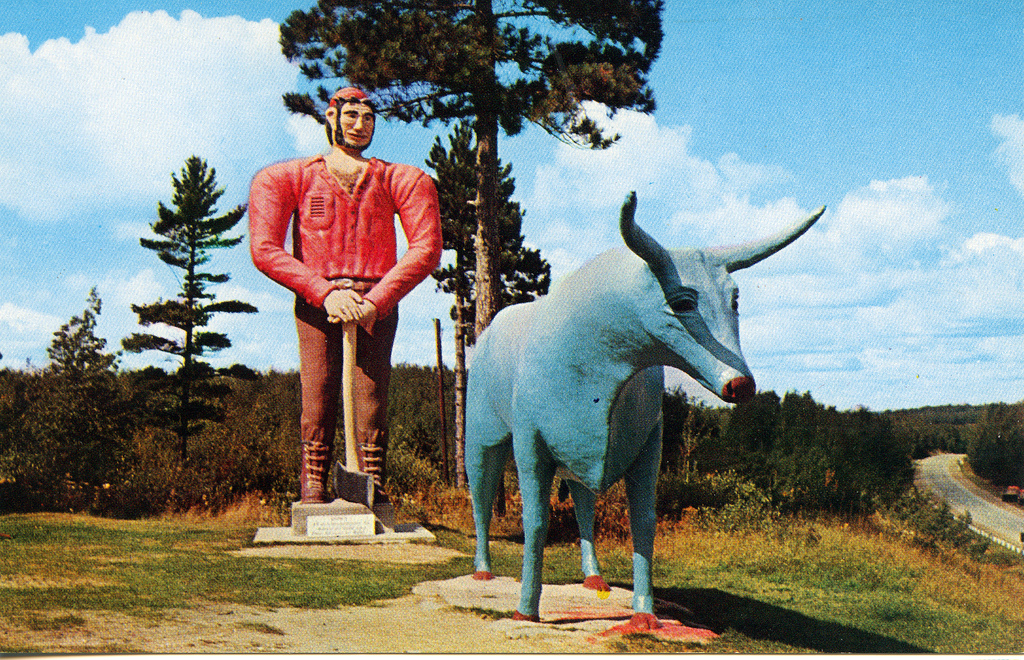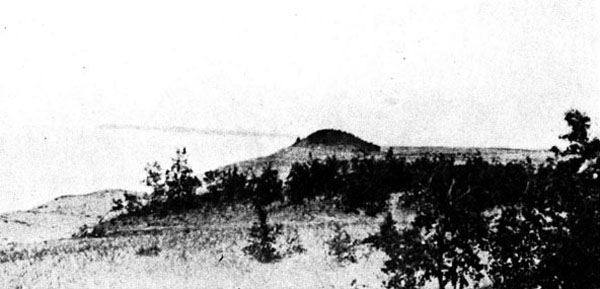STORY LINKS
Devil's Lake
Indian Giants
Mysterious
Lake Michigan
Le Nain Rouge
Paul Bunyan
Sleeping Bear
Dune
Valley
of the Giants
History of
Old Bottles
Michigan
Salt Mines
Kitch-iti-kipi
Eastern Massasauga
Osage Orange
Past Articles
Questions, comments, submissions, & advertising
Contact BPP
|

 Michigan Chronoscope - Stories on the fringe of history
Michigan Chronoscope - Stories on the fringe of history
Chronograph Numeral IV - Fall 2017 - Page Four
|
Paul Bunyan from Michigan?
 Paul Bunyan and Babe the Blue Ox Statue near Alpena
Paul Bunyan and Babe the Blue Ox Statue near Alpena
Probably one of the biggest tall tales to come out of American folklore is the tale of Paul Bunyan. This larger-than-life logger from the 19th century is one of the most popular mythical American heroes to this day. A giant man with a giant ox who could do almost anything when challenged seems to be an impossible character created from the one-up stories told by loggers with huge imaginations. These tales are said to have likely come about during evenings in the lumber camps when the lumberjacks would try to spin ever more outrageous stories to outdo the last storyteller. However, like all great legends, there is an original story with a grain of truth that sprouted into a giant of a legend.
Several characters in several regions are given credit for starting the story of Paul Bunyan. These stories were around for some thirty years before being published in print, so it may be there were several real people the legend was based upon. Being from Michigan, I naturally prefer the idea that the story originally came from here.
The earliest recorded reference to Paul Bunyan is a story from 1904 printed in the Duluth News Tribune.
"His pet joke and the one with which the greenhorn at the camp is sure to be tried, consists of a series of imaginative tales about the year Paul Bunyan lumbered in North Dakota. The great Paul is represented as getting out countless millions of timber in the year of the 'blue snow.' The men's shanty in his camp covered a half section, and the mess camp was a stupendous affair. The range on which an army of cookees prepared the beans and 'red horse' was so long that when the cook wanted to grease it up to bake the wheat cakes in the morning, they strapped two large hams to his feet and started him running up and down a half mile of the black glistening stove top."
These story elements are likely from the earliest tales about Paul Bunyan as they have been retained in most of the Paul Bunyan stories since then. Given that first printed story, it seems likely that Paul came from the Dakotas, however, it may merely mean that the popular retelling of his story comes from this first one in print. Some researchers into Paul's stories have concluded that his character is based on two possible lumberjacks here in Michigan.
Researchers D. Laurence Rogers and Juliana L'Heureux' suggested a connection between Paul Bunyan and the French-Canadian lumberjack Fabian Fournier. From 1865 to 1875, Fournier worked for the H. M. Loud Company near Grayling, Michigan.
Born in Quebec around 1845, Fournier went to Michigan after the Civil War. He was a large, strong man who was good with a double-bit axe. Fournier was said to be six feet tall and had large, powerful hands. Fournier was a true Michigan legend himself known by the nickname Saginaw Joe. He was large in stature and known to be an outstanding lumberjack. He also was said to have two sets of teeth and was a tough guy willing to pick a fight. He eventually died in 1875 after a bar fight in Bay City Michigan.
Around that time there were stories about another French-Canadian named Bon Jean, a soldier who was considered a war hero. It's possible that Fournier's and Bon Jean's stories merged into the Paul Bunyan character. Having relatives from the thumb area and knowing someone related to Saginaw Joe, I'll give Fournier the benefit of being the real-life Paul Bunyan.
Comment about this article on the
Epress Forum Board
.

|
|
|
Legend of Sleeping Bear Dune
 Old picture of Sleeping Bear Dune
Old picture of Sleeping Bear Dune
Sleeping Bear Dune is a sand dune on the shore of Lake Michigan located along the northwest coast of Leelanau and Benzie counties near Empire, Michigan. From the days before white settlement the silhouette of Sleeping Bear Dune appeared to be a huge bear lying down and facing Lake Michigan. The shape of this natural feature gave rise to a Native American myth attributed to the Ojibwa (AKA the Chippewa) tribe referred to as the Legend of Sleeping Bear Dune. Here is the story as retold today.
Long ago in the region now known as Wisconsin, lived Mishe Mokwa, or Mother Bear, and her twin cubs. One day, a great wildfire engulfed the Wisconsin forest that drove Mishe Mokwa and her cubs to flee for their lives. Mother Bear and her cubs ran and ran until they reached the shore of Lake Michigan and could go no further.
Because Mishe Mokwa and her cubs were great swimmers they plunged into the lake and began swimming. Knowing there was no turning back, Mishe Mokwa and her cubs swam east away from the roaring flames and searing heat. Having a reserve of body fat and being powerful swimmers Mishe Mokwa and her cubs were able to swim through that day and then through the night. Although good swimmers, the cubs were not as strong as Mother Bear who had to encourage and urge the weary cubs. Eventually the cubs tired and lagged behind then sometime during the night Mother Bear lost them in the darkness.
Late the following day as Mishe Mokwa continued to swim to the east she saw the white dunes on the eastern shore of Lake Michigan. When she came to the beach and looked back, her cubs could not be seen. She called to them with received no answer, so she climbed the dunes to look farther across the great lake. With sunset approaching she saw her cubs struggling far off in the cold waters. Her heart was broken as she saw them disappear beneath the waves, one after the other.
Exhausted and saddened by the loss of her cubs, she lay on the dune for many days, staring at the water where her cubs had drowned waiting in the hope that her cubs would finally reappear. Gitche Manitou, the Great Spirit, was so moved by her mourning, determination, and faith that he raised two islands, North Manitou, and South Manitou to commemorate the loss of the brave cubs. Knowing that Mother Bear's heart would never heal, Gitche Manitou caused Mother Bear to fall into a deep sleep and covered her with sand to protect her like a blanket. So now after all this time, Mother Bear sleeps beneath the dune forever sleeping and dreaming of the happy days before she lost her cubs in the deep cold waters of Lake Michigan.
In this version of the legend, Mother Bear and her cubs flee from a fire, another version states they left for greener pastures across the lake due to hunger. It is also claimed in one version that she watched them drown as they crossed.
The Sleeping Bear Dune, although it has changed shape and size over the years due to erosion, is still a popular tourist spot at the Sleeping Bear Dunes National Lakeshore. The sandy bluffs at 400 feet above Lake Michigan offer a spectacular view. You can also go camping there, canoe on one of the many inland lakes, hike the trails through the forest, or visit the Manitou Islands in Lake Michigan. You will also have the opportunity for bird watching, wildlife viewing, and enjoying nature. The lakeshore also contains many cultural attractions including the 1871 South Manitou Island Lighthouse, three former Coast Guard stations, and a historic farming district.
Comment about this article on the
Epress Forum Board
.
|
|
Keywords: Michigan, Great Lakes, history, amazing, astonishing, baffling, bizarre, cryptic, curious, different, extraordinary, forgotten, hidden, incredible, inexplicable, legends, lore, lost, myths, obscure, odd, peculiar, rare, stories, strange, surprising, tales, unexplained, unfamiliar, unique, unknown, unusual, weird
|
|



